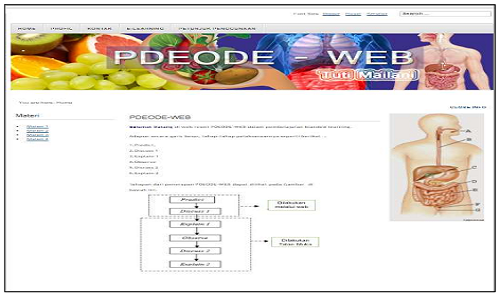
PDEODE-WEB-BASED Blended Learning As 21st Century Learning Development Solutions
Abstract
Keywords
Full Text:
PDFReferences
Ali, M., & Setiani, D. D. (2018). The Effect of Discovery Learning Model on Students’ Learning Result in Fungus Concept. Bioedusiana, 3(2), 59-63.
Dipalaya, T., Susilo, H., & Corebima, A. D. (2016). The Effect Of PDEODE(predict-discuss-explain-observe-discuss-explain) Learning Strategy In The Different Academic Abilities On Students’ Critical Thinking Skills In Senior High School. European Journal of Education Studies, 2(5), 112-125.
Ekawati, N. E.(2018). Application of Blanded Learning with Edmodo Application based on PDEODE Learning Strategy to Increase Student Learning Achievement. Jurnal Ilmiah Pendidikan MIPA. 8(1), 27-32.
Hima, L. R. (2015). The Effect of Blended Learning on Students Motivation in Relation and Function Material. Scientific Journal of Mathematics Education, 2(1), 36-42.
Istiningsih, S & Hasbullah. (2015). Blended Learning, Trend Strategy of Future Learning. Element Journal 1(1), 49-56.
Joanna, P. (2012), Use of Blended Learning To Enhance The Student Learning Experience And Engagement In Property Education, Property management, 30(2), 129-156.
Ministry of Education Republic of Indonesia. (2016). No. 11. Year 2016. Content Standard of Elementary and High School Education Which Contains Competence Level and Core Competence In accordance With the Level and Type of Certain Education. Jakarta: Kemendikbud.
Rahuma, A., & Ananda, A. (2019). The Effect of Using Cooperative Learning Model Type of Examples Non Examples and Motivation Toward Student Learning Outcomes. JPPI (Journal of Educational Research Indonesia), 4(2), 117-121.
Mahmudi.(2006). The Implementation of ARCS Learning Model on Statistics Material in Grade XI of State Senior High School 2 RSBI Banda Aceh. Journal of Opportunity, 2(1), 13-18.
Moskal.P, Dziuban. C, Hartman, J. (2013). Blended learning: A dangerous idea? Internet and Higher Education,18(1), 15-23.
Mulyono, Sulistiyoningsih, S, Kartono. (2015). PBL With Adiwiyata Nuance With Blended Learning to Improve The Ability of Problem Solving and Caring Environment Character. Unnes Journal of Mathematics Education Research,4 (2).
Riduwan. (2009). Basics of Statistics. Bandung: Alfabeta.
Ruhama, D. M, & Setyoko.(2017). Developing Website Based Blended Learning at Biology Education Study Program University of Samudra. Journal of Biology Education 6(3), 346-350.
Solihudin. (2018). Developing Web Based e-Module to Improve Competence Achievement of Physics Knowledge on Static and Dynamic Electricity Materia in Senior High Schoo. Journal of Physics Education Media, 3(2), 51-61.
Sudarman, S., & Mulawarman, U. (2018). The Effect of Blended Learning Strategy on Learning Achievement of Concept and Procedure on Students who Have Self Regulated Learning. Journal of Education and Learning, 21(1).
Titin. E,S & Panjaitan. R.G. (2016). Developing E-Comic Billingual Media Channel Sub Material and Digestive Glands. Unnes Science Education Journal, 5(3).
Utama, Y. (2011). Web Based Information System. Journal of Information System (JSI), 3(2), 359-370.
Wardani, D.N, Anselmus J.E. Toenlioe, Agus W. (2019). Daya Tarik Pembelajaran Di Era 21 Dengan Blended Learning. JKTP,1(1).
Wulandari. (2018). Developing Quality Mathematics Learning Media ICT Based. In National Seminar of Graduate Program X- ITS UNESA, Surabaya.
Yuliandari, S., & Wahyudi, E. (2014). Developing Interactive Multimedia Based Learning Media for Economic Subject Material Adjustment Journal of Service Company. Journal of Accounting Education (JPAK), 2(2).
DOI: http://dx.doi.org/10.31258/jes.5.2.p.364-373
Refbacks
- There are currently no refbacks.
Copyright (c) 2021 Zulfarina Zulfarina

This work is licensed under a Creative Commons Attribution 4.0 International License.
Publisher: FKIP Universitas Riau












